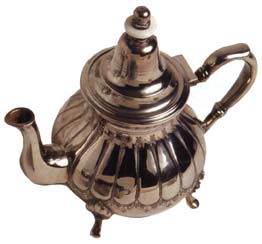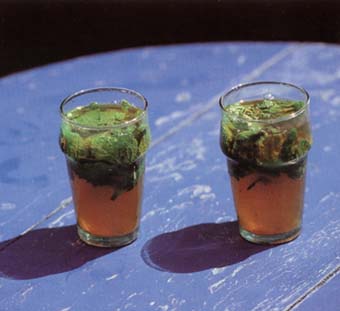Terebess
szórólapok
«
szórólapok listája
MAROKKÓI TEÁZÁS
„A
teáskanna magában foglalja az egész világegyetemet. Pontosabban, a tálca képviseli
a földet, a teáskanna az eget, a poharak az esőt; az eget és a földet pedig az
eső egyesíti.”
Abdallah Zrika
A berberek Észak-Afrikában évszázadok óta isszák a kínai zöld teát mentával, s bizonyára ezért is olyan virulóan egészségesek. Reggel és este, hétköznap és ünnepnap, bármikor, bármilyen alkalommal ezt kínálják mosolyogva barátnak és idegennek. A teázás szertartása a legendás marokkói vendéglátás része. A háztartásokban általában két, rézből vagy Britannica-fémből készült, cizellált asztalka van, egy nagyobb és egy kisebb. A nagyobbra helyezik a teáskannákat és az üveg teás poharakat, a kisebbre három henger alakú fémdoboz kerül, amely a zöld tea, a menta vagy az illatos füvek és a darabos cukor tárolására szolgál. A ház ura elhelyezkedik a füstölgő szamovár és a teázó asztalkák előtt, forró vízzel kiöblíti a teáskannákat, mindegyikbe tesz két-három kiskanálnyi zöld teát, ráönt még egy fél pohár forró vizet, ízlés szerint cukordarabokat ad hozzá, majd a még mindig forrásban lévő vízből teletölti a kannákat. Néhány perc múlva az így elkészített italt megkeveri egy kanállal, megkóstolja, aztán egyszerre két kannából csorgatva a teát, félig tölti a poharakat. Az első főzet a legízletesebb, ha igazán kiváló teából készítették, akkor menta nélkül isszák. Mialatt a vendégek ízlelgetik, értékelik az első pohár teát, a házigazda hozzálát a második forrázat előállításához. Ezúttal egy jó marék, szárával együtt szedett, friss mentát morzsolgat a kannába, majd egy-egy kiskanálnyi új teát is tesz a régi keverékhez, hozzáadja a szokásos cukoradagot és a forró vizet is. Gondosan vigyáz arra, hogy a menta ne jöjjön fel a víz színére, befedi a kannákat vagy a szamovár kéményére helyezi őket és hagyja tartalmukat ázni. Néhány perc múlva lendületesen felkavarja egy kanállal és megkóstolja a főzetet. Természetesen ilyenkor még sohase találja elég jónak, ezt megkívánja a vendége iránti kötelező figyelem és udvariasság is. Újabb cukrot, újabb mentát tesz a teába, hagyja őket összeérni, s nyugodtan várja az eredményt. Többszöri kóstolgatás után, mindkét kezében egy-egy kannát tartva, teletölti vendégei poharát, melyek köznapi használatra közönséges üvegből, ünnepekre átlátszó vagy színes kristályból készültek. A teájukhoz mentával és ánizssal ízesített apró süteményt kínál, lehetőleg jó édeset. A harmadik főzethez már aromásabb fűszereket (fehér üröm, vasfű, majoranna, bazsalikom, narancsvirág) is kervernek. Bizonyos házaknál télen már az első adagok készítésekor ezt teszik, mivel ilyenkor a friss menta ritka és nem eléggé illatos. A marokkóiak a meknes-i mentát értékelik a legtöbbre, azt tartják, hogy az egyenesen a hetedik paradicsomból került le a földre.
Lásd
még! Marokkói
ízek - Terebess fűszerkalauz
Marokkói
receptek
Szakács
Imre: Marokkói receptek
Horváth
Boldizsárné: Marokkói receptek

Fotó: Helmich Zoltán
Moroccan tea being served. It is poured from a distance to produce a foam on the tea.



Moroccan tea culture (Arabic : ياشلا - al-shāy, Moroccan Arabic : ياتا - Ataí) is defined by the way tea (exclusively green tea) is prepared and consumed in Morocco, where it is widely consumed with food. The tradition has also spread throughout North Africa , parts of the Sahel, and southern Spain. Tea occupies a very important place in Moroccan culture and is considered an art form. Morocco is one of the biggest tea importers of the world. Moroccan mint tea is a green tea with mint leaves. Moroccan-style mint tea is now commonly served all through the West Arab World (North Africa). It is served not only at mealtimes but all through the day, and it is especially a drink of hospitality, commonly served whenever there are guests. Unlike Moroccan food, cooked by women, this tea is traditionally a man's affair: prepared by the head of the family. It is served to guests, and it is impolite to refuse it. Morocco, Tunisia and Algeria, countries where it is most often drunk, consume respectively 1.4, 1.5 and 0.7 kg of tea yearly per capita.
Origins It is believed that green tea was first introduced to Morocco in the 18th century, and began spreading through the country in the mid-19th century at the time the trade between the Maghreb and Europe started flourishing. It is reported that Sultan Moulay Ismail received many bags of tea and sugar as gifts and recompenses given by European envoys in order to release European prison ers. The main provider of tea to Morocco remains China . According to the Moroccan trade ministry, Morocco imported more than $56 million worth of Chinese tea during the first half of 2006. Morocco is considered the first importer of Chinese green tea worldwide.
Preparation The method of preparation of atai is relatively complex and varies from region to region. It is normally sweeter in the north of Morocco than in the south, and in some places, pine nut s are added. In the winter, if mint is rare, sometimes leaves of wormwood (chiba or sheeba in Moroccan Arabic) are substituted for (or used to complement) the mint, giving the tea a distinctly bitter flavor. Lemon Verbena (louiza in Moroccan) is also used to give it a lemony flavor.
The typical green tea used is a gunpowder tea variety imported from China. A simple and practical method runs as follows:
• In a teapot, combine two teaspoons of tea-leaf with half a litre of boiling water. Allow it to steep for at least fifteen minutes.
• Without stirring, filter the mixture into a different stainless steel pot, so that the tea leaves and coarse powder are removed.
• Add sugar (about one teaspoon per decilitre).
• Bring to boil over a medium heat. This important step in the preparation process allows the sugar to undergo hydrolysis, giving the tea its distinctive taste.
• If desired, add fresh mint leaves to the teapot or directly to the cup. Remember to remove the mint within two minutes, as it can give some people acid reflux.
Nowadays many Moroccans choose to drink green tea without mint because of health concerns related to the large quantities of pesticides used in mint cultivation. Traditionally the tea is served three times, and the amount of time the tea has been steeping gives each of the three glasses of tea a unique flavor, described in this famous proverb:
Le premier verre est aussi amer que la vie, le deuxième est aussi fort que l'amour, le troisième est aussi doux que la mort.
The first glass is as bitter as life, the second glass is as strong as love, the third glass is as gentle as death.